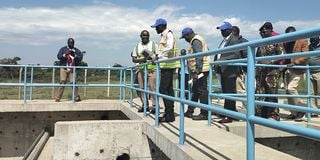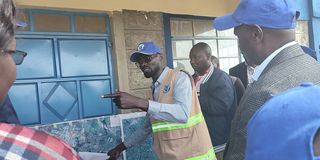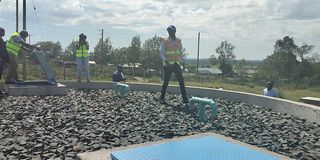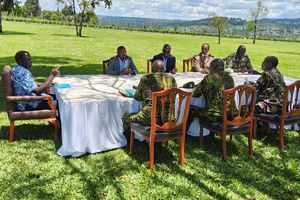
Water Cabinet Secretary Eric Mugaa (third left) inspecting the water supply and sanitation systems for Kilgoris and Lolgorian towns in Narok County on October 11, 2024.
Swahili people’s saying ‘mgeni njoo mwenyeji apone, (the coming of a visitor is a blessing to the host) appears to have found a practical meaning in once a sleepy village in Trans Mara, Narok County.
This is after several development projects popped up with the entry of President William Ruto’s palatial home built on a swathe of land, estimated to be over 900 acres, in Lolgorian— some 23 kilometres southwest of Kilgoris town.
Among the developments the Head of State’s private home has brought to the people of Trans Mara is a Sh600 million water project which is expected to serve more than 13,000 households.
The land where the president has set up his home was initially owned by the former Vice President Joseph Murumbi, who died in 1990.
Some lobby groups and members of the Maasai community had staged a spirited fight in court, succeeding in having more than 1,000 acres of the same land allocated to the Moitanik clan.
However, the existence of Dr Ruto’s Lolgorian home is now proving to be a blessing to the locals as major government-initiated development projects have started trickling in.
Apart from the water project, there is the Kilgoris-Lolgorian-Angata Barrikoi tarmac road which is nearing completion.
The road leading into the president’s homestead, off the tarmac, gives breathtaking views of the beautiful landscaping that has transformed the once forested and bushy land into a canopy of attractive trees.
Increased security
The homestead is also highly guarded by officers from the General Service Unit (GSU), bringing with it increased security along the Kilgoris-Lolgorian road, which years back was characterised by banditry.
The paved path becomes the third tarmac road in the whole of Kilgoris Constituency which for many years lagged behind in development.

Water Cabinet Secretary Eric Mugaa (centre) inspects the water supply and sanitation systems for Kilgoris and Lolgorian towns in Narok County on October 11, 2024.
The other two are the Nyangusu-Kilgoris and Kilgoris-Emurua Dikirr roads.
Earlier this year President Ruto, during the burial of Mama Annah Tikui Noolparakuo Tunai at Lolgorian, said he had held meetings with local leaders over the region's development.
"We talked about this region's development agenda. Roads, water, electricity, affordable housing and markets. I want to assure you that we will have these developments," said Dr Ruto.
"As a villager here, I am proposing the prioritisation of several roads from this region. We have the Lolgorian-Aitong-Mararianda-Ololung'a road, it may not be done in a year, but we will ensure it is part of our plan in the next three to four years. We will build this road and many others that will be proposed by my neighbours."
The President tickled the gathering when he said; "I indeed neighbour this homestead. Mr Tunai (former Narok governor) and I are of the same Nyumba Kumi. When we call a Nyumba Kumi meeting, he is our chairman and we plan our things there.”
For the longest time, the local Maa community has lived in the wilderness, quite practically, living and feeding within the natural habitat of the Maasai Mara Game Reserve, which is in the neighbourhood.
Notably, Dr Ruto's 35-roomed mansion has lately become the centre of power as the president often retreats to it for high-calibre meetings such as those on the security of the country.
Apart from the president’s family and state officials who occasionally visit the home, the president keeps cattle and cultivates crops on the farm.
On the mega water project, Water Cabinet Secretary Eric Mugaa said during an inspection tour on Friday: “The water supply project, which is at 90 percent to completion, will serve 13,000 households in Lolgorian and Kilgoris and their environs. The project, which should be ready by December this year, will produce two million litres of water every day."
The project taps its water from River Mugor, and it will be treated and pumped into two raised tanks in Lolgorian and Kilgoris for further supply through gravity.
Sh10 billion
The project is being undertaken by the Central Rift Valley Water Works Development Agency and Lake Victoria South Water Works Development Agency as the engineers.
A distribution network of 13 kilometres and eight kilometres has been done in the environs of Kilgoris and Lolgorian, respectively.

Water Cabinet Secretary Eric Mugaa (centre) inspects the water supply and sanitation systems for Kilgoris and Lolgorian towns in Narok County on October 11, 2024.
There will be a second phase of the project, to be done in collaboration with the Narok Water and Sewerage Company, of connecting homes and fixing meters for billing.
“Fitting metres will enable us to properly manage operations and maintenance costs. As a country we have a challenge of non-revenue water which stands at 42 percent, translating to about Sh10 billion every year,” he explained.
He went on: “We are sensitising our companies, in collaboration with county governments, to minimise loss."
Phase 2 of the project will entail solarisation to take advantage of the ever-available sunshine.
“Narok has a lot of solar. Instead of double pumping from the river to the hills, we are looking at the option of solar systems to supplement Kenya Power bills,” he said.
As such, the project will benefit from a hybrid power system of solar during the day and electricity at night.
A similar project is taking shape at Kegonga in Kuria East, Migori County, after it was launched by President Ruto on August 28 this year.
CS Mugaa noted that the project was now eight percent to completion and would eventually produce 1 million litres of water per day to benefit some 11,000 people.
The construction works are projected to end after 13 months, with the project envisioned to last for at least 20 years without any major repairs.
“Proper maintenance must be done to ensure value for money and we are asking our water companies to help in maintenance,” said Mr Mugaa.
The project is funded by the Africa Development Bank, in partnership with the national government.









